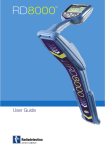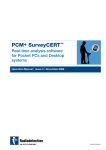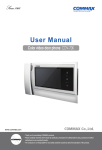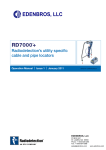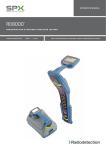Download RD4000TL UG.indd
Transcript
RD4000TL RECEIVER RD4OOOTL RD4000T10 TRANSMITTER Primary Operations: 1 On/Off Key, Menu Select Receiver on/off. Press and hold for off. Secondary operation menu = momentary press (see below). 2 Numeric Signal Display Indicates signal response and measurement units being used. 3 Frequency/Mode Indicator Displays the selected frequency or operating mode. 4 Left/Right Arrows Indicates direction of target line (automatic in Null mode). 5 Numeric Display Displays the current gain value. 6 Power Mode Power mode selected. 7 Radio Mode Radio mode selected. 8 Line Selected Indicator Line mode selected. 9 Sonde Indication Sonde mode selected. 10 Bar Graph Telecommunications - advanced location & fault finding The RD4000TL cable and pipe locator has been introduced to meet the demand for an advanced locator dedicated to the telecommunications industry. This guide provides a quick, step by step reference to the applications of the RD4000TL and the T3 and T10 transmitters. Displays signal strength (dB or %). Peak is indicated by a lone bar 11 Fault Find (FF) mode ‘8k Fault Find’ via the A-Frame. 12 Antenna Display Narrow Peak (twin horizontal antenna), Null (vertical antenna). 13 Battery Level Displays battery level. No locate is possible at minimum (zero bars). 14 Depth or Current Display Displays depth or current as applicable. 15 Fault Find Arrows Indicates the direction along the pipe/utility to the measured fault. www.radiodetection.com RD4000T3(F) TRANSMITTER Display Features 16 Antenna Select Key Press and release selects Peak or Null mode. Sustained press switches between depth and current if available. 17 Gain Controls Signal strength is indicated on bar graph (50% is suitable). Unit automatically servos to mid-scale gain if signal outside useful operating zone. Sustained hold of gain-up or gain-down = steps of 1dB increment/decrement. 18 Function Key Press and release to select the required frequency/operating mode. Secondary Operations: Function Key & Gain Up/Down Scrolls through operating modes - press gain up and down & function key together. Function Key Sustained Hold through power-on sequence: Unit displays firmware revision (DSP, FPGA), unit configuration number and the date unit last calibrated. Power On/Off Key Momentary Press Set volume (4 levels) and battery type (Alkaline, NiMH). Up & Down gain arrows used to select options. Second press selects the applicable menu. Volume Control Up & Down gain arrows scroll through settings (VOL0, VOL1, VOL2, VOL3). Momentary press of On/Off confirms selection and exits menu. Battery Selection Operation identical to volume control. Select type to match to battery level indicator (alkaline or NiMH). To Disable a Mode Key menu select (1). Scroll to required mode using arrow (17) and (1). 1 On/Off Key Switches the transmitter on and off and acts as the menu select key. 2 Measurement Indicator Indicates which measurement is being taken. 3 Induction Mode Symbol displayed when induction mode is selected. 4 Transmitter Indication Symbol displayed the entire time the transmitter is switched on. 5 Clamp Indicator Symbol Displayed when a Signal Clamp is connected. 6 Direct Connection Indicator Symbol Displayed when transmitter is connected to line using direct connection. 7 Text Display Displays operating mode, frequency submode and menus/alarms. 8 Numeric Frequency Display Displays the output frequency and measurement units being used. 9 Hi-Volts Symbol displayed when 50V output max is selected. 10 Volume Level Displays volume level (mute, low, medium, high). Display Features 12 Battery Level Displays transmitter battery level. 13 Bar-graph Displays output current or power setting demanded. 14 Numeric Measurement Display Displays numeric measurement information including the units being used. 15 Up Key Press to increase power output, or to scroll up through menu options and parameters. If power output is increased to above 5 Watts, Hi-Power will scroll across the screen, this will significantly increase drain on the batteries. 16 Down key Press to decrease power output or to scroll down through menu options and parameters. 17 Measurement Key Press to select measurement units: Amps/Volts in normal mode and Volts/Ohms in measurement mode. 18 Live Cable Warning Indicates when there is more than 30V on the output terminals. 1 On/Off Key Switches the transmitter on and off. The T3(F) will self-test for 2 secs, then switch to induction mode, or direct connection mode if connection leads are present. 2 Fault Find Indicator (FF) LED indicates that FF mode is selected. 3 Frequency Indicators LED’s indicate the selected frequency. 4 Power Output LED’s indicate the selected output level. 5 Induction indicator LED indicates when induction mode is selected. 6 Up Key Press to increase power output. 7 Down Key Press to reduce power output. 8 Frequency Key Press repeatedly to scroll through and select the required frequency. Before doing this ensure that a connection lead is fitted. 19 Frequency Key Press and release to select the required frequency. Holding the key scrolls through the available frequencies, release when the required frequency is displayed. 11 External Power Supply Indicator Symbol displayed when external power supply is connected. 90/UG068ENG-01 LOCATING LOCATING How to use a stethoscope Plug the stethoscope into the receiver accessory socket. Select Stethoscope (Probe) using the Function key (2); mode shows P and frequency e.g. P640. Press the concave head against each cable in turn to detect a maximum signal. Passive Frequencies These rely on signals already present on buried metal utilities and do not require the use of a Radiodetection transmitter. There are two types of passive frequency. Power Power Power cables and some other utilities radiate a signal at 50/60Hz. Types of stethoscope Radio In addition to power signals, some utilities re-radiate ambient radio signals. Radio Active Frequencies These require the use of a Radiodetection transmitter to provide the locate signal, and give very good depth and current readings. These frequencies also travel greater distances and can help to identify individual lines. Remember the transmitter and receiver must be set to the same frequency. There are three methods of applying an active signal using a Radiodetection transmitter. Induction Direct Connection Induction The transmitter is placed over or near the area to be located and switched to the appropriate frequency. A signal will then be induced on to any line(s) below or close to the transmitter. Higher frequencies are normally used in this method as they induce more effectively. Direct Connection Electrical connection leads are plugged into the transmitter and attached directly to the line, the circuit is completed by connection to a ground stake (typically at 90° to the line). This method ensures a strong clear signal on an individual line and enables the use of lower frequencies, for example current direction. Signal Clamp A Signal Clamp is plugged into the transmitter and clamped around the line to couple the signal to it. A range of Signal Clamps is available to accommodate most conductors. Stethoscopes The RD4000TL supports the stethoscope antennas shown on the next page. LOCATING 90mm 3.5in FAULT FINDING Depth and Current Measurement (CM) Fault Find (FF) • Depth and Current is displayed automatically where applicable. An A-Frame is used with RD4000 receiver and transmitter to locate cable sheath-to-ground faults on power and telco lines. See below. • It is important to position stationary over located line. 1.Taking a reference reading Note: The cm feature measures the actual current on Small stethoscope antenna The small stethoscope antenna has a 25mm/1in concave head at the end of a 2m/78 inch lead. The small stethoscope can be screwed into an extension rod or used at the end of several extension rods joined together for identifying the line regardless of its depth. Therefore the receiver’s strongest response may not come from the target line; it may come from a shallow line to which the signal has coupled. Large stethoscope antenna The large stethoscope antenna, which plugs into the receiver accessory socket, is used for cable identification in situations where the cable is exposed. It is particularly useful for identifying heavy cables lying in a tray where it is not possible to fit a clamp. The concave detector head on the end of the insulated, flexible gooseneck is placed firmly against the cable to be identified. If there are a number of cables, the stethoscope antenna will give the strongest response from the cable to which the transmitter signal has been applied. A sonde is a small self contained transmitter that, when inserted in a non-metallic drain, sewer, pipe or duct, can be located by the receiver. Locating a Sonde • Select sonde (18). • Select Peak mode (16). • Hold the receiver vertically with the blade in line with the sonde. Peak Ghost Ghost Peak Mode • Move from side to side over the suspected position of the sonde, to obtain a peak response. Ghost peaks will be found on either side of a main peak response. • With the centre peak pinpointed move the receiver back and forth across the line of the sonde to obtain a second peak. • Select Peak mode (16). • Set the Gain (17) so that the bar graph is at approximately 50%. • Rotate the receiver to obtain a third peak response. The receiver is now directly over the sonde and a depth measurement will automatically be displayed. • Hold the receiver vertical and sweep the area with a steady and deliberate motion. If necessary adjust the gain to keep the bar graph on scale. • Current measurement is not applicable to sondes. • When a signal is detected continue along the search route until it reduces, then move back to where the signal is strongest (Peak). • Rotate the receiver until the signal is at its weakest. The receiver handle will now be aligned with the target line. • Move the receiver from side to side using small movements until a clear maximum is observed. The receiver is now directly over the target line. When to use a stethoscope • Depth and Current, as selected, is automatically displayed. At times, it may not be possible to put a clamp around a cable because of congestion or because of inaccessibility. A stethoscope antenna should be used in the place of the clamp to identify cables. • You can follow the line by moving forward while at the same time moving the receiver from side to side, observing the maximum response. • Signal overload eg. Near a substation transformer. Bar graph will flash. Depth and Current not displayed. Safety Information The rechargeable battery packs can be recharged via a vehicle cigarette lighter. Rechargeable battery packs must not be recharged whilst attached to transmitter or locator units, if the vehicle is being driven. Transmitter variants can by powered via the vehicle cigarette lighter of a stationary vehicle. The RD4000 is designed for use by suitably trained personnel, following procedures and instructions described in the full user manual. For comprehensive approval, warning and safety information, refer to the full RD4000 user manual. • Pinpoint the line and trace its route for a short distance. • Connect the A-frame to the receiver. Select 8KFF (18) FF mode selected and A-frame symbol displayed. • Select FF mode on the transmitter and ensure the ground stake is connected. Red Green Line fa ult ahead RD4000T10 • Press on/off (1) to select the menu and scroll using the down arrow (3) to select FF. • Press on/off (1) again to confirm the selection. RD4000T3F • Press the frequency key (8) until the FF LED is lit. • Place the A-frame spikes in the ground approx. 2 meters from the ground stake and with the green spike facing it. • Ensure the receiver is in line with the A-frame and facing the green spike. The FF arrows should point away from the ground stake. • Make note of the dB reading. During fault find, if the dB reading is approx. equal to the reference there is a single fault. If the dB reading is less than the reference there are multiple faults, in this case the sum of all dB readings should be approx. equal to the reference. 2. Fault Finding • Place the A-frame spikes in the ground with the red spike nearest the ground stake. • The FF arrows will display the fault direction. The arrows should point away from the ground stake and the bar graph should read zero. • Follow the cable pushing the A-Frame spikes into the ground at regular intervals and checking for FF arrows. With no fault, the arrows will flicker on and off and the dB readings will be erratic. • Keep the red spike facing the ground stake and keep the receiver in line with the A-Frame. Near a fault, the arrows will lock on and the dB reading will increase. • Move in the direction of the arrows. Find the point at which the arrows change direction. • Rotate through 90° and move back and forth to locate the fault in this direction, the intersection point will be directly over the fault. • Should the location of the cable become uncertain the mode select key (18) can be used to change between locate mode and FF mode. VΩ readings (RD4000T10 only) This function can be used to confirm the presence of a fault. Note: All earth bonds MUST be removed from the cable. • Press on/off (1) to select the menu and scroll using the down arrow (16) to select Measure. • Press on/off (1) again to confirm the selection • Press the measurement key (17) to select ohms and take a resistance reading. A low resistance (typically less than 2MΩ) indicates a fault. Line fa ult behind




